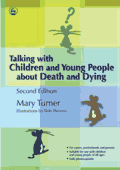 (second edition) by Mary Turner (Illustrations by Bob Thomas) 2006, 160 pages,Paperback £19.99 ISBN 1-84310-441-5
(second edition) by Mary Turner (Illustrations by Bob Thomas) 2006, 160 pages,Paperback £19.99 ISBN 1-84310-441-5
Over the past 8 years, I have had the privilege of working with and learning from, primary school children in my local Church of England school There is a straight forwardness about children, an innocence and openness, which bring life and challenge. Their natural curiosity, sense of wonder and of the divine all combine to give children a profound connectedness with their fears, worries, dreams and nightmares.
One of the most significant pastoral experiences in the life of the school community has been the unexpected death of a young child. When this tragedy happened, one of the things that most surprised me was the widespread inability to engage with the reality of death in a way that was able to connect with the concerns of children experiencing grief and loss. This is, perhaps, understandable – it is not easy to connect with often frightening thoughts, fears and worries. It is difficult to embrace the paradoxes and uncertainties around loss when our natural tendency is to want to put right the loss and say something that will make it all feel better.
In that situation, this book would certainly have been a useful tool for this pastor and my school community. Written out of considerable experience, the writer manages to hold together some complex theories about bereavement and apply them to pastoral practice. It reminds the reader to exercise care and self- awareness. The process undergirding the book takes the reader steadily through this complex area of human experience and gently encourages the communication of pain and the often contradictory emotions that are aroused by death.
The book (produced in A4 format) is divided into two sections. There is a useful introduction offering guidance for those who seek help. This first part then examines manifestations of distress and offers some practical points for bereaved adults. Turner then takes the reader through some guidance about how best to tackle discussion and conversation, and reminds her reader of the importance of support and knowledge of other sources of help. The substantial part of the book is entitled
Resource – Subjects for Facilitated Discussion. These subjects include death and dying, saying goodbye, thinking about funerals, talking about someone who has died, engaging with thoughts and feelings, fears and worries, dreams and nightmares, the community of friends, family and the school, remembering and going on. The book is splendidly illustrated by Bob Thomas, who uses his own experience to illuminate the areas for further work and discussion. The book is designed to be an inter-active resource with many of the pages photo-copiable, which allows the user to take time to explore their emotional worlds. The expression of emotion and thought here is simple and direct, with some moving pieces of poetry and prose.
Mary Turner proves herself to be a wise guide and has produced a resource which deserves to be drawn upon, not only at difficult moments, but throughout the life journey. Death and dying ought to be made an integral part of the school curriculum for all children at every age. How else are we to achieve a greater sense of ability to integrate our dying into living and thus address our spiritual self and our destiny?
James Woodward